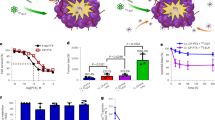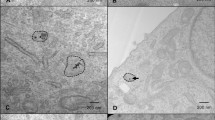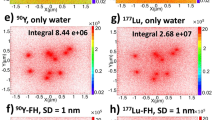Abstract
Brachytherapy (BRT) is used in the treatment of human cancers, including the cervix, breast, prostate and head and neck cancers. The primary advantage of BRT lies in the spatial conformation of the radiation deposition. Previously, we have shown that similar techniques (using hollow metallic cylinders) may be used to deliver gene-therapy vectors capable of expressing the radiation-sensitizing cytokine, tumor necrosis factor (TNF)-α, within a restricted volume of tissue. Herein, we report radiation sensitization of cancer cells using a TNF-α expressing vector driven by the radiation-inducible immediate-early gene-1 (IEX-1) promoter (pIEX-TNF-α). TNF-α, determined by ELISA assays using culture medium, increased between 5 and 10 fold, 48 h following exposure to radiation, and radiation sensitization was comparable with that observed in cells in which TNF-α was constitutively expressed under cytomegalo viral (CMV) promoter using the plasmid vector (pCMV-TNF-α). This efficiency of induced TNF-α radiation sensitization was also observed in cervix (SW756) and prostate tumor (PC-3) xenograft models. IEX-1-driven TNF-α expression following external radiation exposure resulted in enhanced regression of tumor xenografts as compared with radiation alone. A feasibility of using radioactive Pd-103 seeds with GeneSeeds was further examined using PC-3 xenograft models. The data showed substantial tumor growth suppression following co-implantation with a metal seed containing Pd-103. Taken together, these results show the enhanced effect on tumor regression by treatment with radiation-inducible TNF-α expression in combination with radiation and support for the IEX-1 promoter as a useful regulator for temporal activation of radiation-sensitizing gene expression.
This is a preview of subscription content, access via your institution
Access options
Subscribe to this journal
Receive 12 print issues and online access
$259.00 per year
only $21.58 per issue
Buy this article
- Purchase on Springer Link
- Instant access to full article PDF
Prices may be subject to local taxes which are calculated during checkout




Similar content being viewed by others
References
Dattoli M, Wallner K, Sorace R, Koval J, Cash J, Acosta R et al. 103Pd Brachytherapy and external beam irradiation for clinically localized, high-risk prostatic carcinoma. Int J Radiat Oncol Biol Phys 1996; 35: 875–879.
Blasko J, Grimm P, Radge H . Brachytherapy and organ preservation in the management of carcinoma of the prostate. Semin Radiat Oncol 1993; 3: 240–249.
Radge H, Elgamal A, Snow P, Brandt J, Bartolucci A, Nadir B et al. Ten-year disease free survival after transperineal sonography-guided iodine-125 brachytherapy with or without 45-gray external beam irradiation in the treatment of patients with clinically localized, low to high gleason grade prostate carcinoma. Cancer 1998; 83: 989–1001.
American Society for Therapeutic Radiology and Oncology Consensus Panel. Consensus Statements on Radiation Therapy of Prostate Cancer: Guidelines for Prostate Re-Biopsy After Radiation and for Radiation Therapy with Rising Prostate-specific Antigen Levels after Radical Prostatectomy. J Clin Oncol 1999; 17: 1155–1163.
Critz F, Tarlton R, Holladay D . Prostate specific antigen-monitored combination radiotherapy for patients with prostate cancer. Cancer 1995; 75: 2382–2391.
McLaughlin PW, Sandler H, Jiroutek M . Prostate-specific antigen following prostate radiotherapy: how low can you go? J Clin Oncol 1996; 14: 2889–2892.
Critz F, Levinson AK, Williams WH, Holladay D . Prostate-specific Antigen Nadir: the optimum level after irradiation for prostate cancer. J Clin Oncol 1996; 14: 2893–2900.
Hanks G, Perez C, Kozar M, Asbell S, Pilepich M, Pajak T . PSA confirmation of cure at 10 years of T1B, T2, N0, M0 prostate cancer patients treated in RTOG protocol 7706 with external beam irradiation. Int J Radiat Oncol Biol Phys 1994; 30: 289–292.
Stock R . Locoregional therapies for early-stage prostate cancer. Oncology 1995; 9: 803–811.
Radge H, Blasko J, Grimm P, Kenny G, Sylvester J, Hoak D et al. Interstitial iodine-125 radiation without adjuvant therapy in the treatment of clinically localized prostate carcinoma. Cancer 1997; 80: 442–453.
Mate T, Gottesman J, Hatton J, Gribble M, Van Hollebeke L . High dose-rate after loading 192Iridium prostate brachytherapy: feasibility report: Int. J Radiat Oncol Biol Phys 1998; 41: 525–533.
Weichselbaum RR, Hallahan DE, Sukhatme VP, Kufe DW . Gene therapy targeted by ionizing radiation. Int. J Radiat Oncol Biol Phys 1992; 24: 565–567.
Murugesan SR, King CR, Osborn R, Fairweather WR, O'Reilly EM, Thornton MO et al. Combination of human tumor necrosis factor-alpha (hTNF-a) gene delivery with gemcitabine is effective in models of pancreatic cancer. Cancer Gene Ther 2009; 16: 841–847.
Weichselbaum RR, Kufe DW . Translation of the radio- and chemo-inducible TNFerade vector to the treatment of human cancers. Rev Cancer Gene Ther 2009; 16: 609–619.
Deorukhkar A, Krishnan S . Targeting inflammatory pathways for tumor radiosensitization. Biochem Pharmacol 2010. Jun 30. (E-pub ahead of print), doi:10.1016/j.bcp.2010.06.039.
Meng Y, Beckett MA, Liang H, Mauceri HJ, van Rooijen N, Cohen KS et al. Blockade of tumor necrosis factor alpha signaling in tumor-associated macrophages as a radiosensitizing strategy. Cancer Res 2010; 70: 1534–1543.
Mauceri HJ, Beckett MA, Liang H, Sutton HG, Pitroda S, Galka E et al. Translational strategies exploiting TNF-alpha that sensitize tumors to radiation therapy. Cancer Gene Ther 2009; 16: 373–381.
Kondratyev A, Chung K-N, Jung M . Identification characterization of radiation-inducible glyclosylated human early response gene. Cancer Res 1996; 56: 1498–1502.
Wu MX, Ao Z, Prasad KV, Wu R, Schlossman SF . IEX-1L, an apoptosis inhibitor involved in NF-κB-mediated cell survival. Science 1998; 281: 998–1001.
Shen L, Zhi L, Hu W, Wu MX . IEX-1 targets mitochondrial F1Fo-ATPase inhibitor for degradation. Cell Death Differ 2009; 16: 603–612.
Muerkoster SS, Rausch AV, Isberner A, Minkenberg J, Blaszczuk E, Witt M et al. The apoptosis-inducing effect of gastrin on colorectal cancer cells relates to an increased IEX-1 expression mediating NF-kB inhibition. Oncogene 2008; 27: 1122–1134.
Jung M, Zhang Y, Dimtohev A, Subramanian M, Suthanthiran K, Dritschilo A . Interstitial gene delivery in human xenograft prostate tumors using titanium metal seeds. Mol Cancer Ther 2004; 3: 655–659.
Acknowledgements
We thank Larry Maxwell, MD Colonel, US Army Medical Corps, Director, Gynecologic Cancer Translational Research Center Chief, for valuable scientific discussion and the Best Medical Industries for manufacturing and providing GeneSeeds, the Biostatistics Resource in the Vincent T Lombardi Cancer Center for statistical collaboration in experimental design and interpretation of results, and Y Zhang, J Tuturea, A Foxworth and T Carr for technical assistance. This work was supported by grants, W81XWH-GDP and PC010401 (to MJ), from the Department of Defense.
Author information
Authors and Affiliations
Corresponding author
Ethics declarations
Competing interests
The authors declare no conflict of interest.
Rights and permissions
About this article
Cite this article
Jung, M., Dimtchev, A., Velena, A. et al. Combining radiation therapy with interstitial radiation-inducible TNF-α expression for locoregional cancer treatment. Cancer Gene Ther 18, 189–195 (2011). https://doi.org/10.1038/cgt.2010.69
Received:
Revised:
Accepted:
Published:
Issue Date:
DOI: https://doi.org/10.1038/cgt.2010.69



